Communication Skills Assessment
VerifiedAdded on 2020/04/01
|20
|4528
|38
AI Summary
This assignment involves assessing your self-perceived communication competence using two scales: the Speech Anxiety Scale and the Self-Perceived Communication Competence Scale (SPCC). You'll rate your anxiety levels during public speaking situations and your perceived competence across various communication contexts. The results from these scales will provide insights into your strengths and areas for improvement in communication skills.
Contribute Materials
Your contribution can guide someone’s learning journey. Share your
documents today.

Running head: EFFECTIVE BUSINESS COMMUNICATION
Effective Business Communication
Name of the Student
Name of the University
Author note
Effective Business Communication
Name of the Student
Name of the University
Author note
Secure Best Marks with AI Grader
Need help grading? Try our AI Grader for instant feedback on your assignments.

1
EFFECTIVE BUSINESS COMMUNICATION
Table of Contents
1: Diagnosis and Reflection:......................................................................................................3
1.1 Diagnostic tools: Personal Report of public speaking Anxiety (PRPSA)........................3
1.2 Self- Perceived Communication Competence Scale (SPCC)..........................................4
2: Literature review:...................................................................................................................7
3. Action Plan...........................................................................................................................10
3.1 Measuring the effectiveness of the undertaken strategies..............................................12
Reference list............................................................................................................................14
Appendix..................................................................................................................................16
EFFECTIVE BUSINESS COMMUNICATION
Table of Contents
1: Diagnosis and Reflection:......................................................................................................3
1.1 Diagnostic tools: Personal Report of public speaking Anxiety (PRPSA)........................3
1.2 Self- Perceived Communication Competence Scale (SPCC)..........................................4
2: Literature review:...................................................................................................................7
3. Action Plan...........................................................................................................................10
3.1 Measuring the effectiveness of the undertaken strategies..............................................12
Reference list............................................................................................................................14
Appendix..................................................................................................................................16
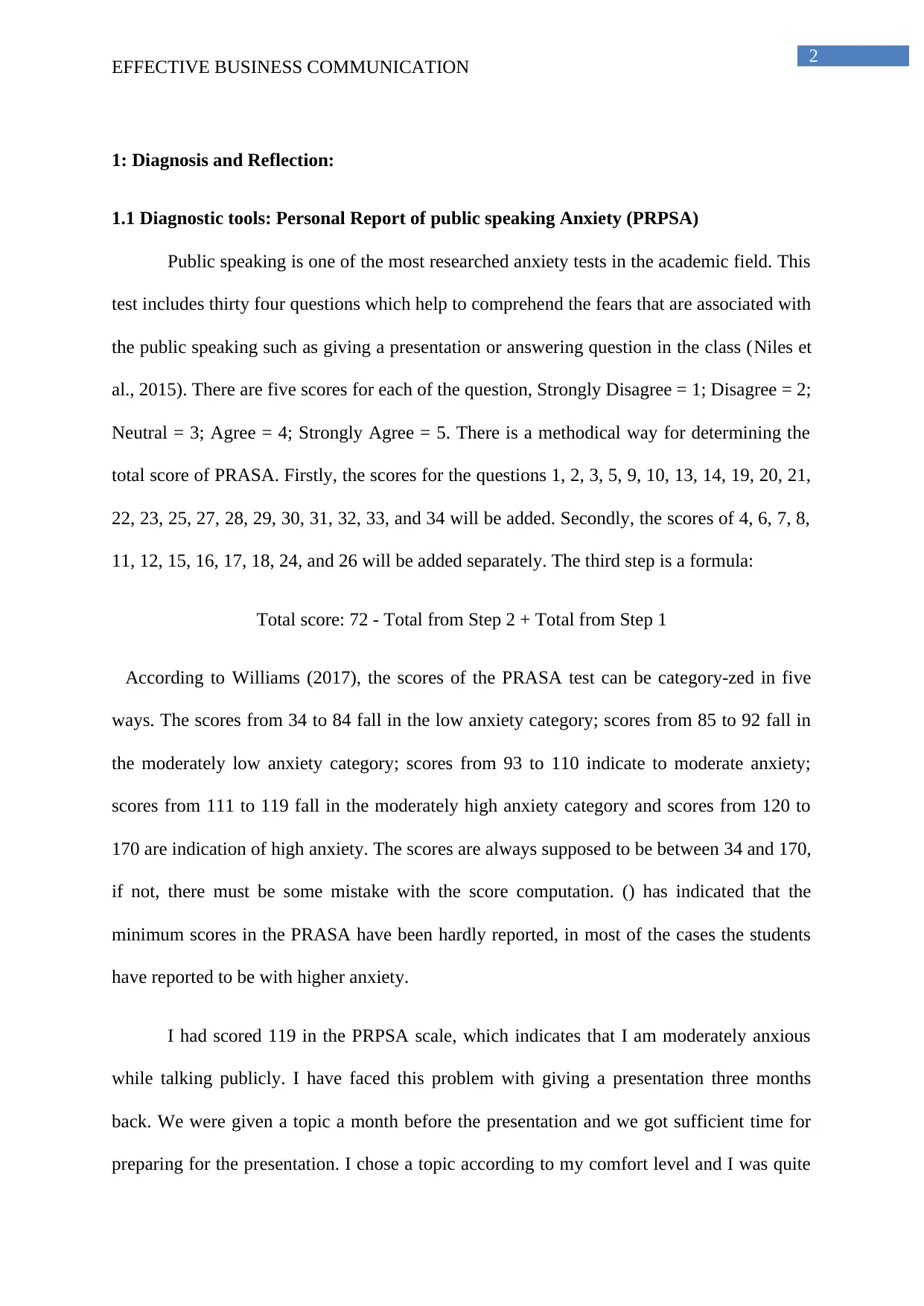
2
EFFECTIVE BUSINESS COMMUNICATION
1: Diagnosis and Reflection:
1.1 Diagnostic tools: Personal Report of public speaking Anxiety (PRPSA)
Public speaking is one of the most researched anxiety tests in the academic field. This
test includes thirty four questions which help to comprehend the fears that are associated with
the public speaking such as giving a presentation or answering question in the class (Niles et
al., 2015). There are five scores for each of the question, Strongly Disagree = 1; Disagree = 2;
Neutral = 3; Agree = 4; Strongly Agree = 5. There is a methodical way for determining the
total score of PRASA. Firstly, the scores for the questions 1, 2, 3, 5, 9, 10, 13, 14, 19, 20, 21,
22, 23, 25, 27, 28, 29, 30, 31, 32, 33, and 34 will be added. Secondly, the scores of 4, 6, 7, 8,
11, 12, 15, 16, 17, 18, 24, and 26 will be added separately. The third step is a formula:
Total score: 72 - Total from Step 2 + Total from Step 1
According to Williams (2017), the scores of the PRASA test can be category-zed in five
ways. The scores from 34 to 84 fall in the low anxiety category; scores from 85 to 92 fall in
the moderately low anxiety category; scores from 93 to 110 indicate to moderate anxiety;
scores from 111 to 119 fall in the moderately high anxiety category and scores from 120 to
170 are indication of high anxiety. The scores are always supposed to be between 34 and 170,
if not, there must be some mistake with the score computation. () has indicated that the
minimum scores in the PRASA have been hardly reported, in most of the cases the students
have reported to be with higher anxiety.
I had scored 119 in the PRPSA scale, which indicates that I am moderately anxious
while talking publicly. I have faced this problem with giving a presentation three months
back. We were given a topic a month before the presentation and we got sufficient time for
preparing for the presentation. I chose a topic according to my comfort level and I was quite
EFFECTIVE BUSINESS COMMUNICATION
1: Diagnosis and Reflection:
1.1 Diagnostic tools: Personal Report of public speaking Anxiety (PRPSA)
Public speaking is one of the most researched anxiety tests in the academic field. This
test includes thirty four questions which help to comprehend the fears that are associated with
the public speaking such as giving a presentation or answering question in the class (Niles et
al., 2015). There are five scores for each of the question, Strongly Disagree = 1; Disagree = 2;
Neutral = 3; Agree = 4; Strongly Agree = 5. There is a methodical way for determining the
total score of PRASA. Firstly, the scores for the questions 1, 2, 3, 5, 9, 10, 13, 14, 19, 20, 21,
22, 23, 25, 27, 28, 29, 30, 31, 32, 33, and 34 will be added. Secondly, the scores of 4, 6, 7, 8,
11, 12, 15, 16, 17, 18, 24, and 26 will be added separately. The third step is a formula:
Total score: 72 - Total from Step 2 + Total from Step 1
According to Williams (2017), the scores of the PRASA test can be category-zed in five
ways. The scores from 34 to 84 fall in the low anxiety category; scores from 85 to 92 fall in
the moderately low anxiety category; scores from 93 to 110 indicate to moderate anxiety;
scores from 111 to 119 fall in the moderately high anxiety category and scores from 120 to
170 are indication of high anxiety. The scores are always supposed to be between 34 and 170,
if not, there must be some mistake with the score computation. () has indicated that the
minimum scores in the PRASA have been hardly reported, in most of the cases the students
have reported to be with higher anxiety.
I had scored 119 in the PRPSA scale, which indicates that I am moderately anxious
while talking publicly. I have faced this problem with giving a presentation three months
back. We were given a topic a month before the presentation and we got sufficient time for
preparing for the presentation. I chose a topic according to my comfort level and I was quite
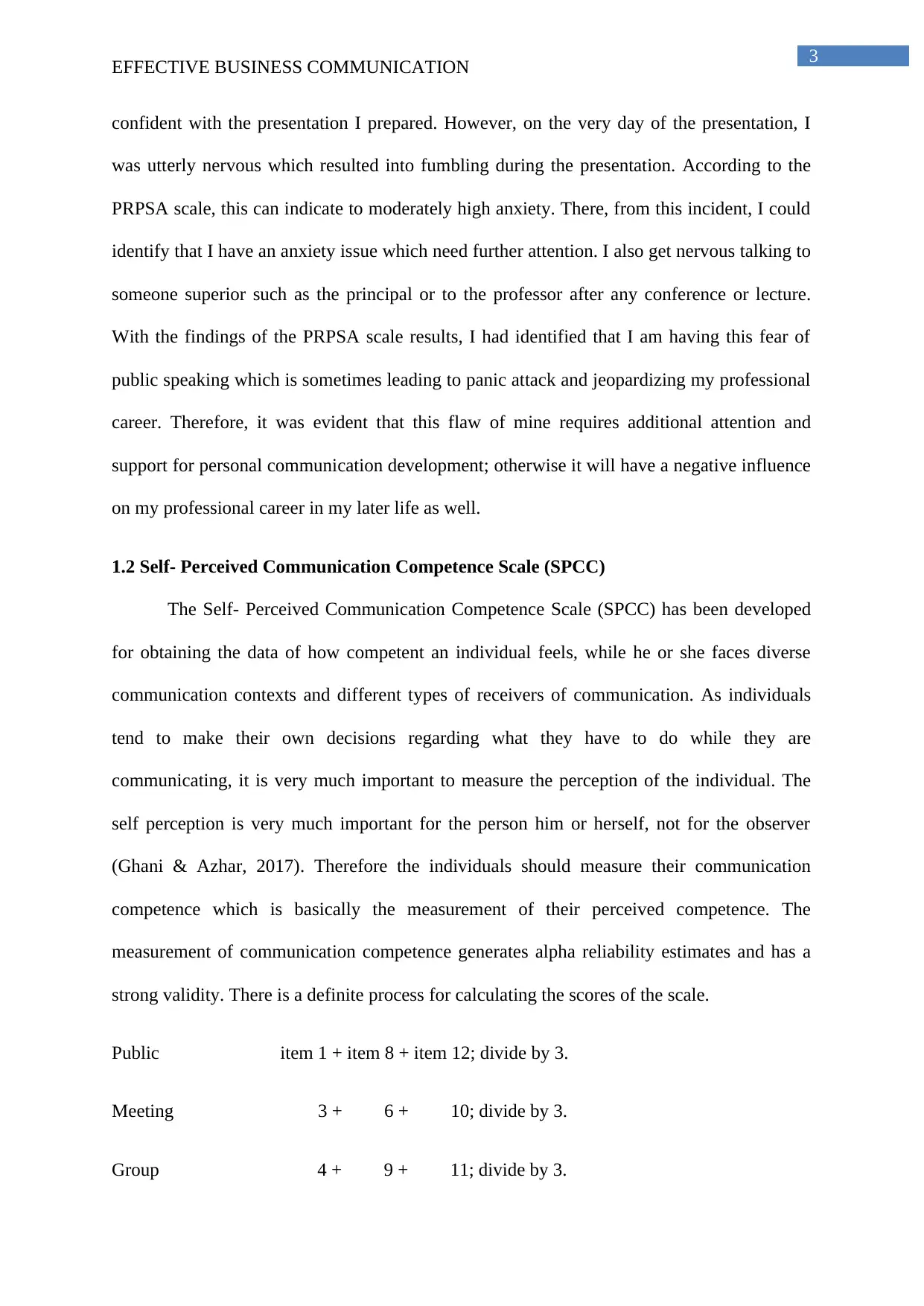
3
EFFECTIVE BUSINESS COMMUNICATION
confident with the presentation I prepared. However, on the very day of the presentation, I
was utterly nervous which resulted into fumbling during the presentation. According to the
PRPSA scale, this can indicate to moderately high anxiety. There, from this incident, I could
identify that I have an anxiety issue which need further attention. I also get nervous talking to
someone superior such as the principal or to the professor after any conference or lecture.
With the findings of the PRPSA scale results, I had identified that I am having this fear of
public speaking which is sometimes leading to panic attack and jeopardizing my professional
career. Therefore, it was evident that this flaw of mine requires additional attention and
support for personal communication development; otherwise it will have a negative influence
on my professional career in my later life as well.
1.2 Self- Perceived Communication Competence Scale (SPCC)
The Self- Perceived Communication Competence Scale (SPCC) has been developed
for obtaining the data of how competent an individual feels, while he or she faces diverse
communication contexts and different types of receivers of communication. As individuals
tend to make their own decisions regarding what they have to do while they are
communicating, it is very much important to measure the perception of the individual. The
self perception is very much important for the person him or herself, not for the observer
(Ghani & Azhar, 2017). Therefore the individuals should measure their communication
competence which is basically the measurement of their perceived competence. The
measurement of communication competence generates alpha reliability estimates and has a
strong validity. There is a definite process for calculating the scores of the scale.
Public item 1 + item 8 + item 12; divide by 3.
Meeting 3 + 6 + 10; divide by 3.
Group 4 + 9 + 11; divide by 3.
EFFECTIVE BUSINESS COMMUNICATION
confident with the presentation I prepared. However, on the very day of the presentation, I
was utterly nervous which resulted into fumbling during the presentation. According to the
PRPSA scale, this can indicate to moderately high anxiety. There, from this incident, I could
identify that I have an anxiety issue which need further attention. I also get nervous talking to
someone superior such as the principal or to the professor after any conference or lecture.
With the findings of the PRPSA scale results, I had identified that I am having this fear of
public speaking which is sometimes leading to panic attack and jeopardizing my professional
career. Therefore, it was evident that this flaw of mine requires additional attention and
support for personal communication development; otherwise it will have a negative influence
on my professional career in my later life as well.
1.2 Self- Perceived Communication Competence Scale (SPCC)
The Self- Perceived Communication Competence Scale (SPCC) has been developed
for obtaining the data of how competent an individual feels, while he or she faces diverse
communication contexts and different types of receivers of communication. As individuals
tend to make their own decisions regarding what they have to do while they are
communicating, it is very much important to measure the perception of the individual. The
self perception is very much important for the person him or herself, not for the observer
(Ghani & Azhar, 2017). Therefore the individuals should measure their communication
competence which is basically the measurement of their perceived competence. The
measurement of communication competence generates alpha reliability estimates and has a
strong validity. There is a definite process for calculating the scores of the scale.
Public item 1 + item 8 + item 12; divide by 3.
Meeting 3 + 6 + 10; divide by 3.
Group 4 + 9 + 11; divide by 3.
Secure Best Marks with AI Grader
Need help grading? Try our AI Grader for instant feedback on your assignments.
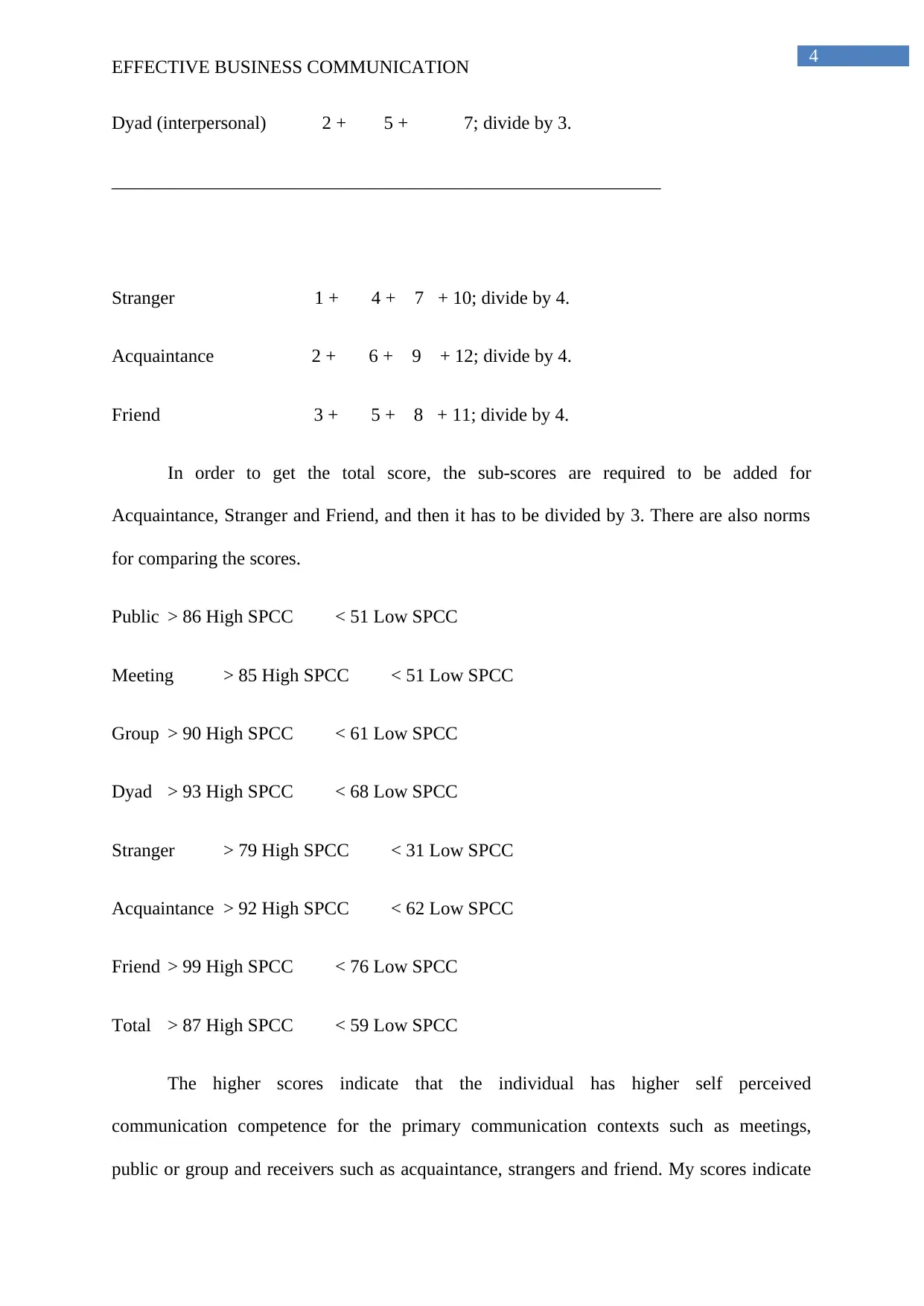
4
EFFECTIVE BUSINESS COMMUNICATION
Dyad (interpersonal) 2 + 5 + 7; divide by 3.
___________________________________________________________
Stranger 1 + 4 + 7 + 10; divide by 4.
Acquaintance 2 + 6 + 9 + 12; divide by 4.
Friend 3 + 5 + 8 + 11; divide by 4.
In order to get the total score, the sub-scores are required to be added for
Acquaintance, Stranger and Friend, and then it has to be divided by 3. There are also norms
for comparing the scores.
Public > 86 High SPCC < 51 Low SPCC
Meeting > 85 High SPCC < 51 Low SPCC
Group > 90 High SPCC < 61 Low SPCC
Dyad > 93 High SPCC < 68 Low SPCC
Stranger > 79 High SPCC < 31 Low SPCC
Acquaintance > 92 High SPCC < 62 Low SPCC
Friend > 99 High SPCC < 76 Low SPCC
Total > 87 High SPCC < 59 Low SPCC
The higher scores indicate that the individual has higher self perceived
communication competence for the primary communication contexts such as meetings,
public or group and receivers such as acquaintance, strangers and friend. My scores indicate
EFFECTIVE BUSINESS COMMUNICATION
Dyad (interpersonal) 2 + 5 + 7; divide by 3.
___________________________________________________________
Stranger 1 + 4 + 7 + 10; divide by 4.
Acquaintance 2 + 6 + 9 + 12; divide by 4.
Friend 3 + 5 + 8 + 11; divide by 4.
In order to get the total score, the sub-scores are required to be added for
Acquaintance, Stranger and Friend, and then it has to be divided by 3. There are also norms
for comparing the scores.
Public > 86 High SPCC < 51 Low SPCC
Meeting > 85 High SPCC < 51 Low SPCC
Group > 90 High SPCC < 61 Low SPCC
Dyad > 93 High SPCC < 68 Low SPCC
Stranger > 79 High SPCC < 31 Low SPCC
Acquaintance > 92 High SPCC < 62 Low SPCC
Friend > 99 High SPCC < 76 Low SPCC
Total > 87 High SPCC < 59 Low SPCC
The higher scores indicate that the individual has higher self perceived
communication competence for the primary communication contexts such as meetings,
public or group and receivers such as acquaintance, strangers and friend. My scores indicate
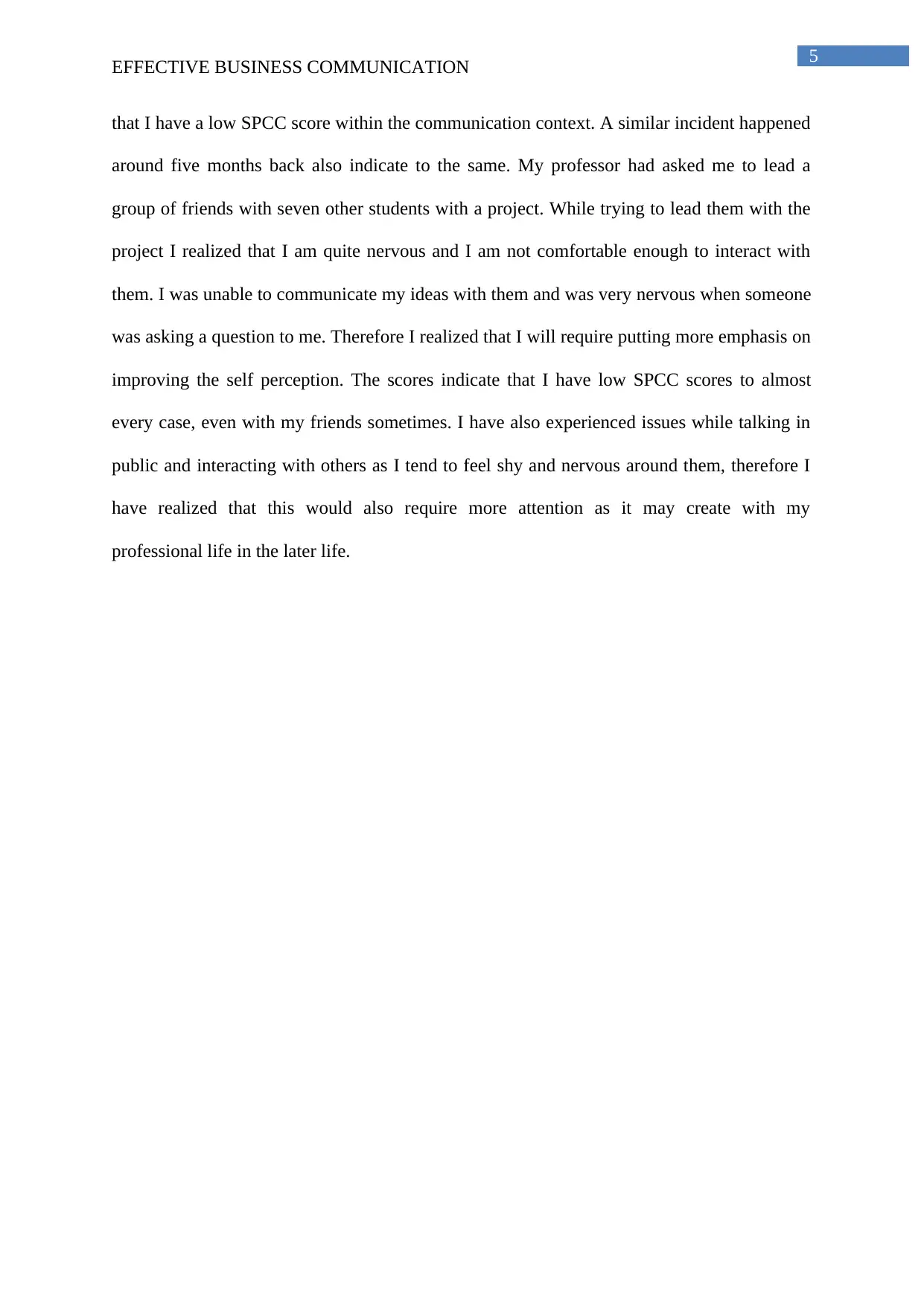
5
EFFECTIVE BUSINESS COMMUNICATION
that I have a low SPCC score within the communication context. A similar incident happened
around five months back also indicate to the same. My professor had asked me to lead a
group of friends with seven other students with a project. While trying to lead them with the
project I realized that I am quite nervous and I am not comfortable enough to interact with
them. I was unable to communicate my ideas with them and was very nervous when someone
was asking a question to me. Therefore I realized that I will require putting more emphasis on
improving the self perception. The scores indicate that I have low SPCC scores to almost
every case, even with my friends sometimes. I have also experienced issues while talking in
public and interacting with others as I tend to feel shy and nervous around them, therefore I
have realized that this would also require more attention as it may create with my
professional life in the later life.
EFFECTIVE BUSINESS COMMUNICATION
that I have a low SPCC score within the communication context. A similar incident happened
around five months back also indicate to the same. My professor had asked me to lead a
group of friends with seven other students with a project. While trying to lead them with the
project I realized that I am quite nervous and I am not comfortable enough to interact with
them. I was unable to communicate my ideas with them and was very nervous when someone
was asking a question to me. Therefore I realized that I will require putting more emphasis on
improving the self perception. The scores indicate that I have low SPCC scores to almost
every case, even with my friends sometimes. I have also experienced issues while talking in
public and interacting with others as I tend to feel shy and nervous around them, therefore I
have realized that this would also require more attention as it may create with my
professional life in the later life.

6
EFFECTIVE BUSINESS COMMUNICATION
2: Literature review:
Most of the people in the surroundings have the fear of speaking in public. For some
this fear becomes so prevalent that the individual may stop interacting with others or making
any face to face interactions or taking any course which may involve active participation
(Wan, 2013). This kind of anxiety can be classified as the state of apprehension and
uneasiness and fear which is caused by anticipating something intimidating. As stated by
Steele & Plenty (2015) the anxiety while speaking publicly is quite common amongst the
students, even though it is quite prevalent amongst the general population as well. The person
with high public speaking anxiety tends to avoid the situations that can provide more anxiety,
however sometimes these situations are unavoidable, such as in college or while taking any
course. In such situations, the individual deal with an intense feeling of distress and anxiety.
According to Homer, Deeprose & Andrade (2016), the anticipatory anxiety can also occur
because the individual may start to imagine about the situation, before it starts happening to
them, or before any kind of actual experience. In most situations, the individuals with the
public speaking anxiety tend to identify that their fear is unreasonable and excessive, but in
most cases they are unable to shift their response without any kind of assistance. There are
several kinds of experiences that can be faced by the individual suffering from public
speaking anxiety such as seating, palpitations, muscle tension, gastrointestinal discomfort,
confusion etc. Baxter (2016) has stated that around eighty five percent of the general
population tend to experience some kind of anxiety or fear while they are speaking in public.
It has also been indicated that the stage fright or the public speaking can be investigated and
cured at some point of time. There are many individuals around who speak for their living
such as politicians, business executives, actors, comedians etc. Sometimes, the students also
have to speak publicly during their courses, for giving any presentation or teaching others or
EFFECTIVE BUSINESS COMMUNICATION
2: Literature review:
Most of the people in the surroundings have the fear of speaking in public. For some
this fear becomes so prevalent that the individual may stop interacting with others or making
any face to face interactions or taking any course which may involve active participation
(Wan, 2013). This kind of anxiety can be classified as the state of apprehension and
uneasiness and fear which is caused by anticipating something intimidating. As stated by
Steele & Plenty (2015) the anxiety while speaking publicly is quite common amongst the
students, even though it is quite prevalent amongst the general population as well. The person
with high public speaking anxiety tends to avoid the situations that can provide more anxiety,
however sometimes these situations are unavoidable, such as in college or while taking any
course. In such situations, the individual deal with an intense feeling of distress and anxiety.
According to Homer, Deeprose & Andrade (2016), the anticipatory anxiety can also occur
because the individual may start to imagine about the situation, before it starts happening to
them, or before any kind of actual experience. In most situations, the individuals with the
public speaking anxiety tend to identify that their fear is unreasonable and excessive, but in
most cases they are unable to shift their response without any kind of assistance. There are
several kinds of experiences that can be faced by the individual suffering from public
speaking anxiety such as seating, palpitations, muscle tension, gastrointestinal discomfort,
confusion etc. Baxter (2016) has stated that around eighty five percent of the general
population tend to experience some kind of anxiety or fear while they are speaking in public.
It has also been indicated that the stage fright or the public speaking can be investigated and
cured at some point of time. There are many individuals around who speak for their living
such as politicians, business executives, actors, comedians etc. Sometimes, the students also
have to speak publicly during their courses, for giving any presentation or teaching others or
Paraphrase This Document
Need a fresh take? Get an instant paraphrase of this document with our AI Paraphraser
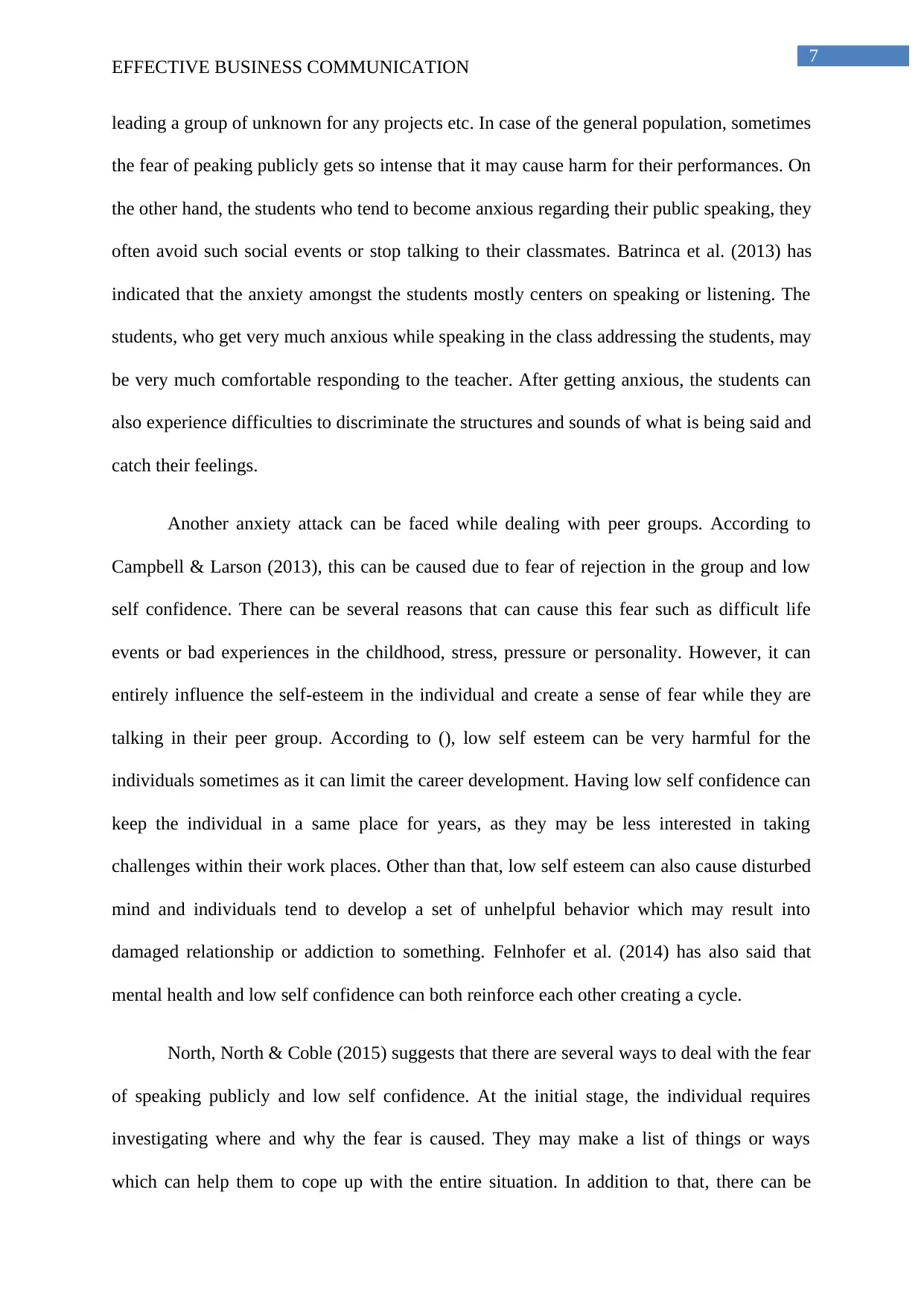
7
EFFECTIVE BUSINESS COMMUNICATION
leading a group of unknown for any projects etc. In case of the general population, sometimes
the fear of peaking publicly gets so intense that it may cause harm for their performances. On
the other hand, the students who tend to become anxious regarding their public speaking, they
often avoid such social events or stop talking to their classmates. Batrinca et al. (2013) has
indicated that the anxiety amongst the students mostly centers on speaking or listening. The
students, who get very much anxious while speaking in the class addressing the students, may
be very much comfortable responding to the teacher. After getting anxious, the students can
also experience difficulties to discriminate the structures and sounds of what is being said and
catch their feelings.
Another anxiety attack can be faced while dealing with peer groups. According to
Campbell & Larson (2013), this can be caused due to fear of rejection in the group and low
self confidence. There can be several reasons that can cause this fear such as difficult life
events or bad experiences in the childhood, stress, pressure or personality. However, it can
entirely influence the self-esteem in the individual and create a sense of fear while they are
talking in their peer group. According to (), low self esteem can be very harmful for the
individuals sometimes as it can limit the career development. Having low self confidence can
keep the individual in a same place for years, as they may be less interested in taking
challenges within their work places. Other than that, low self esteem can also cause disturbed
mind and individuals tend to develop a set of unhelpful behavior which may result into
damaged relationship or addiction to something. Felnhofer et al. (2014) has also said that
mental health and low self confidence can both reinforce each other creating a cycle.
North, North & Coble (2015) suggests that there are several ways to deal with the fear
of speaking publicly and low self confidence. At the initial stage, the individual requires
investigating where and why the fear is caused. They may make a list of things or ways
which can help them to cope up with the entire situation. In addition to that, there can be
EFFECTIVE BUSINESS COMMUNICATION
leading a group of unknown for any projects etc. In case of the general population, sometimes
the fear of peaking publicly gets so intense that it may cause harm for their performances. On
the other hand, the students who tend to become anxious regarding their public speaking, they
often avoid such social events or stop talking to their classmates. Batrinca et al. (2013) has
indicated that the anxiety amongst the students mostly centers on speaking or listening. The
students, who get very much anxious while speaking in the class addressing the students, may
be very much comfortable responding to the teacher. After getting anxious, the students can
also experience difficulties to discriminate the structures and sounds of what is being said and
catch their feelings.
Another anxiety attack can be faced while dealing with peer groups. According to
Campbell & Larson (2013), this can be caused due to fear of rejection in the group and low
self confidence. There can be several reasons that can cause this fear such as difficult life
events or bad experiences in the childhood, stress, pressure or personality. However, it can
entirely influence the self-esteem in the individual and create a sense of fear while they are
talking in their peer group. According to (), low self esteem can be very harmful for the
individuals sometimes as it can limit the career development. Having low self confidence can
keep the individual in a same place for years, as they may be less interested in taking
challenges within their work places. Other than that, low self esteem can also cause disturbed
mind and individuals tend to develop a set of unhelpful behavior which may result into
damaged relationship or addiction to something. Felnhofer et al. (2014) has also said that
mental health and low self confidence can both reinforce each other creating a cycle.
North, North & Coble (2015) suggests that there are several ways to deal with the fear
of speaking publicly and low self confidence. At the initial stage, the individual requires
investigating where and why the fear is caused. They may make a list of things or ways
which can help them to cope up with the entire situation. In addition to that, there can be
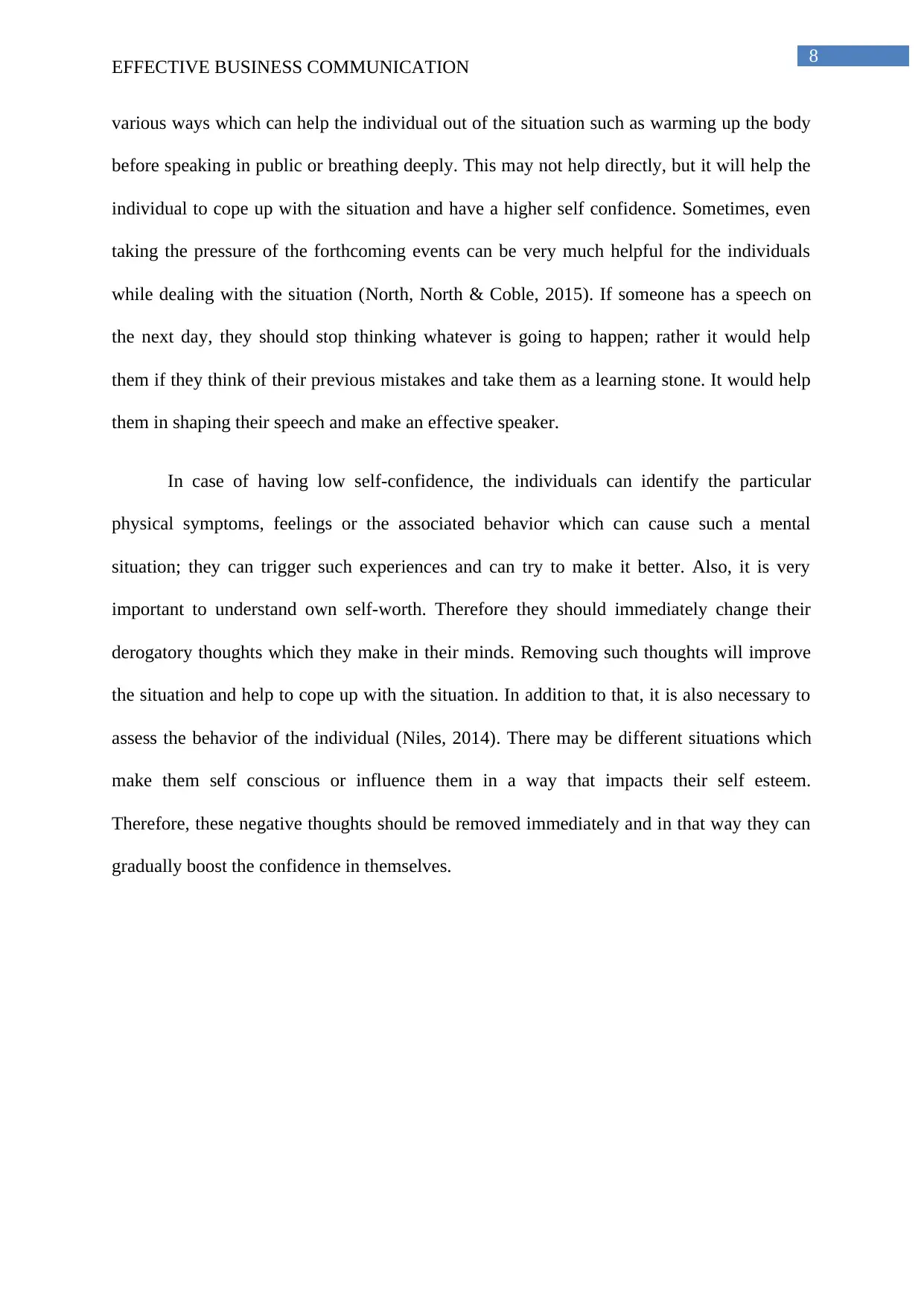
8
EFFECTIVE BUSINESS COMMUNICATION
various ways which can help the individual out of the situation such as warming up the body
before speaking in public or breathing deeply. This may not help directly, but it will help the
individual to cope up with the situation and have a higher self confidence. Sometimes, even
taking the pressure of the forthcoming events can be very much helpful for the individuals
while dealing with the situation (North, North & Coble, 2015). If someone has a speech on
the next day, they should stop thinking whatever is going to happen; rather it would help
them if they think of their previous mistakes and take them as a learning stone. It would help
them in shaping their speech and make an effective speaker.
In case of having low self-confidence, the individuals can identify the particular
physical symptoms, feelings or the associated behavior which can cause such a mental
situation; they can trigger such experiences and can try to make it better. Also, it is very
important to understand own self-worth. Therefore they should immediately change their
derogatory thoughts which they make in their minds. Removing such thoughts will improve
the situation and help to cope up with the situation. In addition to that, it is also necessary to
assess the behavior of the individual (Niles, 2014). There may be different situations which
make them self conscious or influence them in a way that impacts their self esteem.
Therefore, these negative thoughts should be removed immediately and in that way they can
gradually boost the confidence in themselves.
EFFECTIVE BUSINESS COMMUNICATION
various ways which can help the individual out of the situation such as warming up the body
before speaking in public or breathing deeply. This may not help directly, but it will help the
individual to cope up with the situation and have a higher self confidence. Sometimes, even
taking the pressure of the forthcoming events can be very much helpful for the individuals
while dealing with the situation (North, North & Coble, 2015). If someone has a speech on
the next day, they should stop thinking whatever is going to happen; rather it would help
them if they think of their previous mistakes and take them as a learning stone. It would help
them in shaping their speech and make an effective speaker.
In case of having low self-confidence, the individuals can identify the particular
physical symptoms, feelings or the associated behavior which can cause such a mental
situation; they can trigger such experiences and can try to make it better. Also, it is very
important to understand own self-worth. Therefore they should immediately change their
derogatory thoughts which they make in their minds. Removing such thoughts will improve
the situation and help to cope up with the situation. In addition to that, it is also necessary to
assess the behavior of the individual (Niles, 2014). There may be different situations which
make them self conscious or influence them in a way that impacts their self esteem.
Therefore, these negative thoughts should be removed immediately and in that way they can
gradually boost the confidence in themselves.
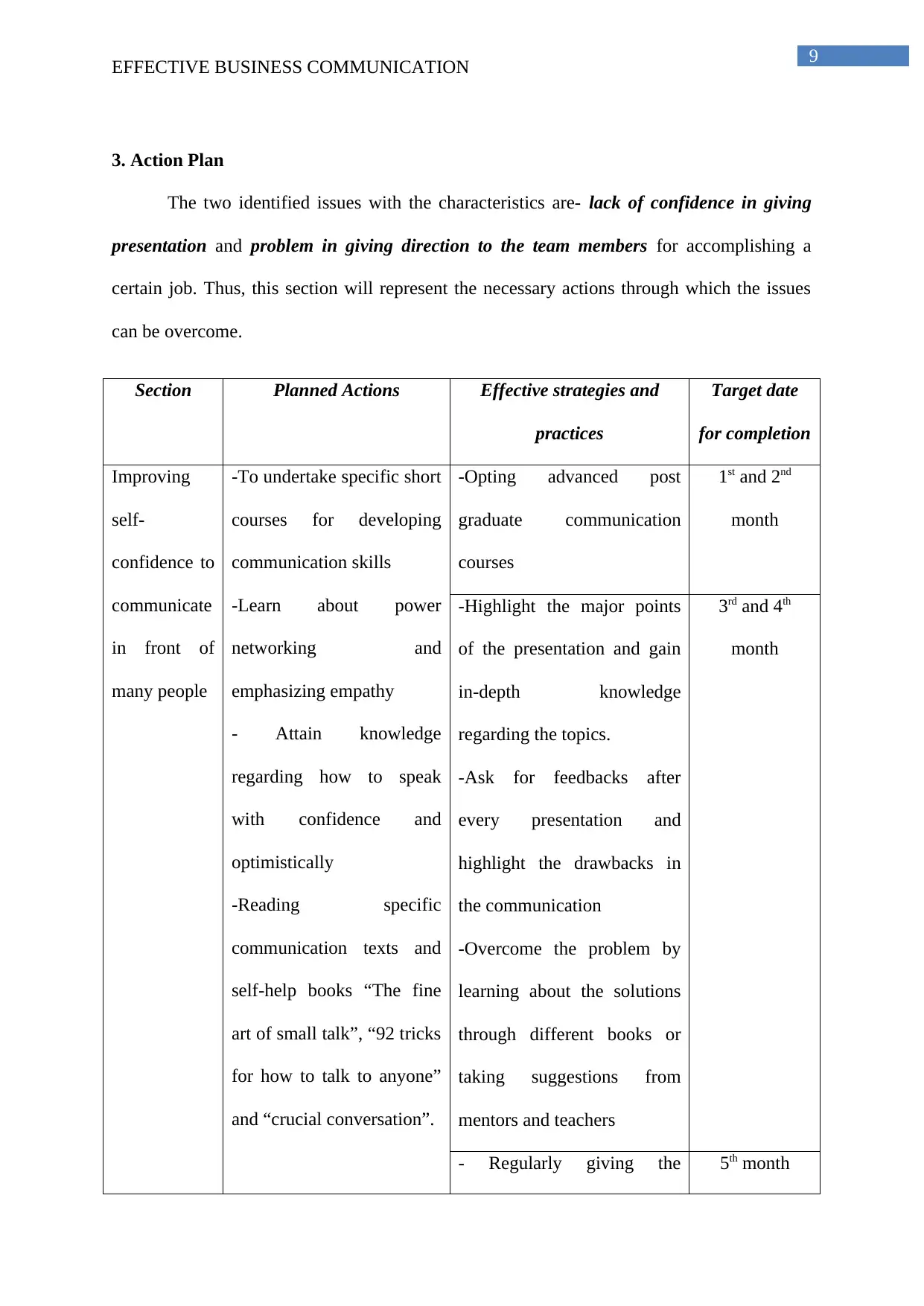
9
EFFECTIVE BUSINESS COMMUNICATION
3. Action Plan
The two identified issues with the characteristics are- lack of confidence in giving
presentation and problem in giving direction to the team members for accomplishing a
certain job. Thus, this section will represent the necessary actions through which the issues
can be overcome.
Section Planned Actions Effective strategies and
practices
Target date
for completion
Improving
self-
confidence to
communicate
in front of
many people
-To undertake specific short
courses for developing
communication skills
-Learn about power
networking and
emphasizing empathy
- Attain knowledge
regarding how to speak
with confidence and
optimistically
-Reading specific
communication texts and
self-help books “The fine
art of small talk”, “92 tricks
for how to talk to anyone”
and “crucial conversation”.
-Opting advanced post
graduate communication
courses
1st and 2nd
month
-Highlight the major points
of the presentation and gain
in-depth knowledge
regarding the topics.
-Ask for feedbacks after
every presentation and
highlight the drawbacks in
the communication
-Overcome the problem by
learning about the solutions
through different books or
taking suggestions from
mentors and teachers
3rd and 4th
month
- Regularly giving the 5th month
EFFECTIVE BUSINESS COMMUNICATION
3. Action Plan
The two identified issues with the characteristics are- lack of confidence in giving
presentation and problem in giving direction to the team members for accomplishing a
certain job. Thus, this section will represent the necessary actions through which the issues
can be overcome.
Section Planned Actions Effective strategies and
practices
Target date
for completion
Improving
self-
confidence to
communicate
in front of
many people
-To undertake specific short
courses for developing
communication skills
-Learn about power
networking and
emphasizing empathy
- Attain knowledge
regarding how to speak
with confidence and
optimistically
-Reading specific
communication texts and
self-help books “The fine
art of small talk”, “92 tricks
for how to talk to anyone”
and “crucial conversation”.
-Opting advanced post
graduate communication
courses
1st and 2nd
month
-Highlight the major points
of the presentation and gain
in-depth knowledge
regarding the topics.
-Ask for feedbacks after
every presentation and
highlight the drawbacks in
the communication
-Overcome the problem by
learning about the solutions
through different books or
taking suggestions from
mentors and teachers
3rd and 4th
month
- Regularly giving the 5th month
Secure Best Marks with AI Grader
Need help grading? Try our AI Grader for instant feedback on your assignments.
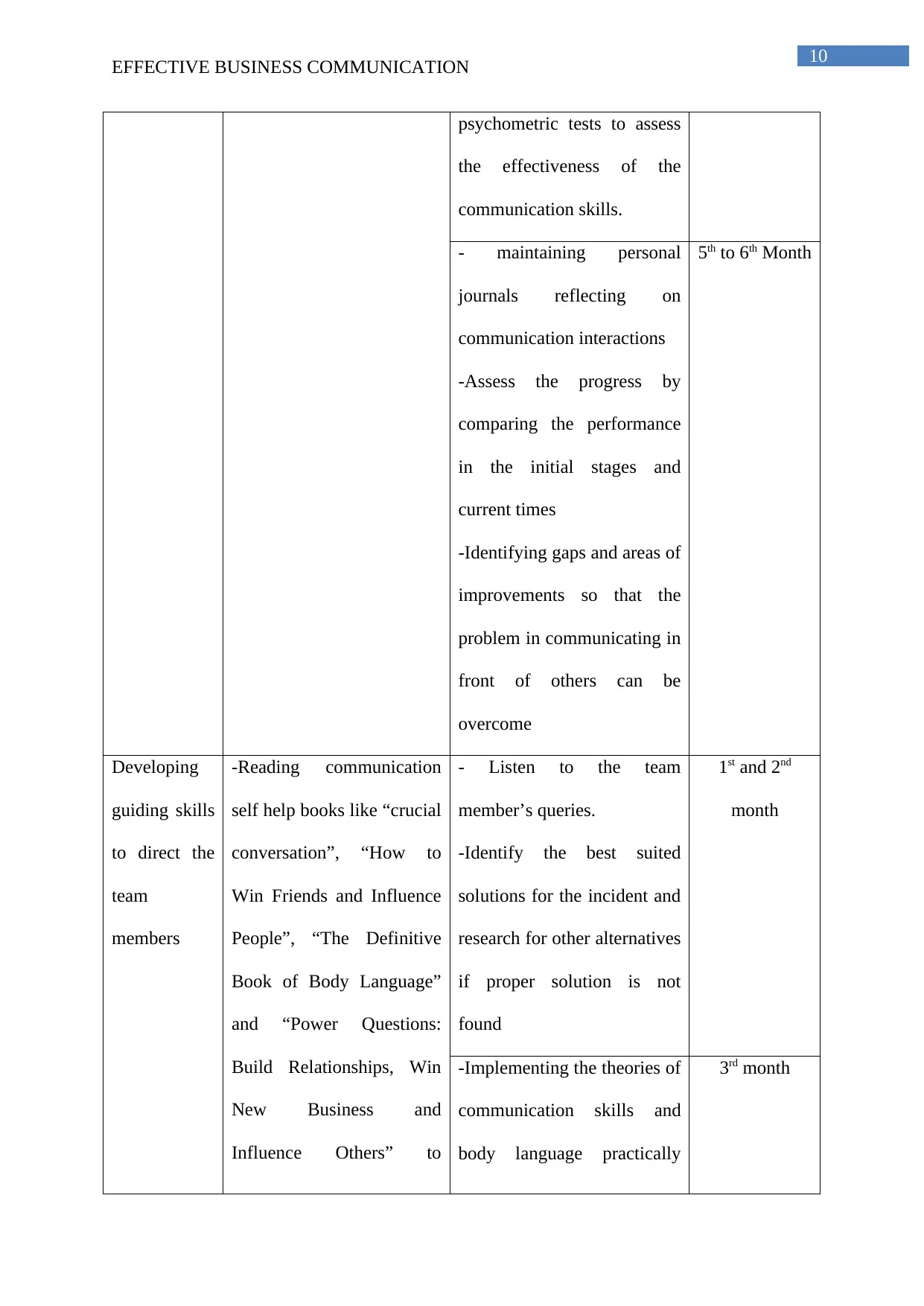
10
EFFECTIVE BUSINESS COMMUNICATION
psychometric tests to assess
the effectiveness of the
communication skills.
- maintaining personal
journals reflecting on
communication interactions
-Assess the progress by
comparing the performance
in the initial stages and
current times
-Identifying gaps and areas of
improvements so that the
problem in communicating in
front of others can be
overcome
5th to 6th Month
Developing
guiding skills
to direct the
team
members
-Reading communication
self help books like “crucial
conversation”, “How to
Win Friends and Influence
People”, “The Definitive
Book of Body Language”
and “Power Questions:
Build Relationships, Win
New Business and
Influence Others” to
- Listen to the team
member’s queries.
-Identify the best suited
solutions for the incident and
research for other alternatives
if proper solution is not
found
1st and 2nd
month
-Implementing the theories of
communication skills and
body language practically
3rd month
EFFECTIVE BUSINESS COMMUNICATION
psychometric tests to assess
the effectiveness of the
communication skills.
- maintaining personal
journals reflecting on
communication interactions
-Assess the progress by
comparing the performance
in the initial stages and
current times
-Identifying gaps and areas of
improvements so that the
problem in communicating in
front of others can be
overcome
5th to 6th Month
Developing
guiding skills
to direct the
team
members
-Reading communication
self help books like “crucial
conversation”, “How to
Win Friends and Influence
People”, “The Definitive
Book of Body Language”
and “Power Questions:
Build Relationships, Win
New Business and
Influence Others” to
- Listen to the team
member’s queries.
-Identify the best suited
solutions for the incident and
research for other alternatives
if proper solution is not
found
1st and 2nd
month
-Implementing the theories of
communication skills and
body language practically
3rd month
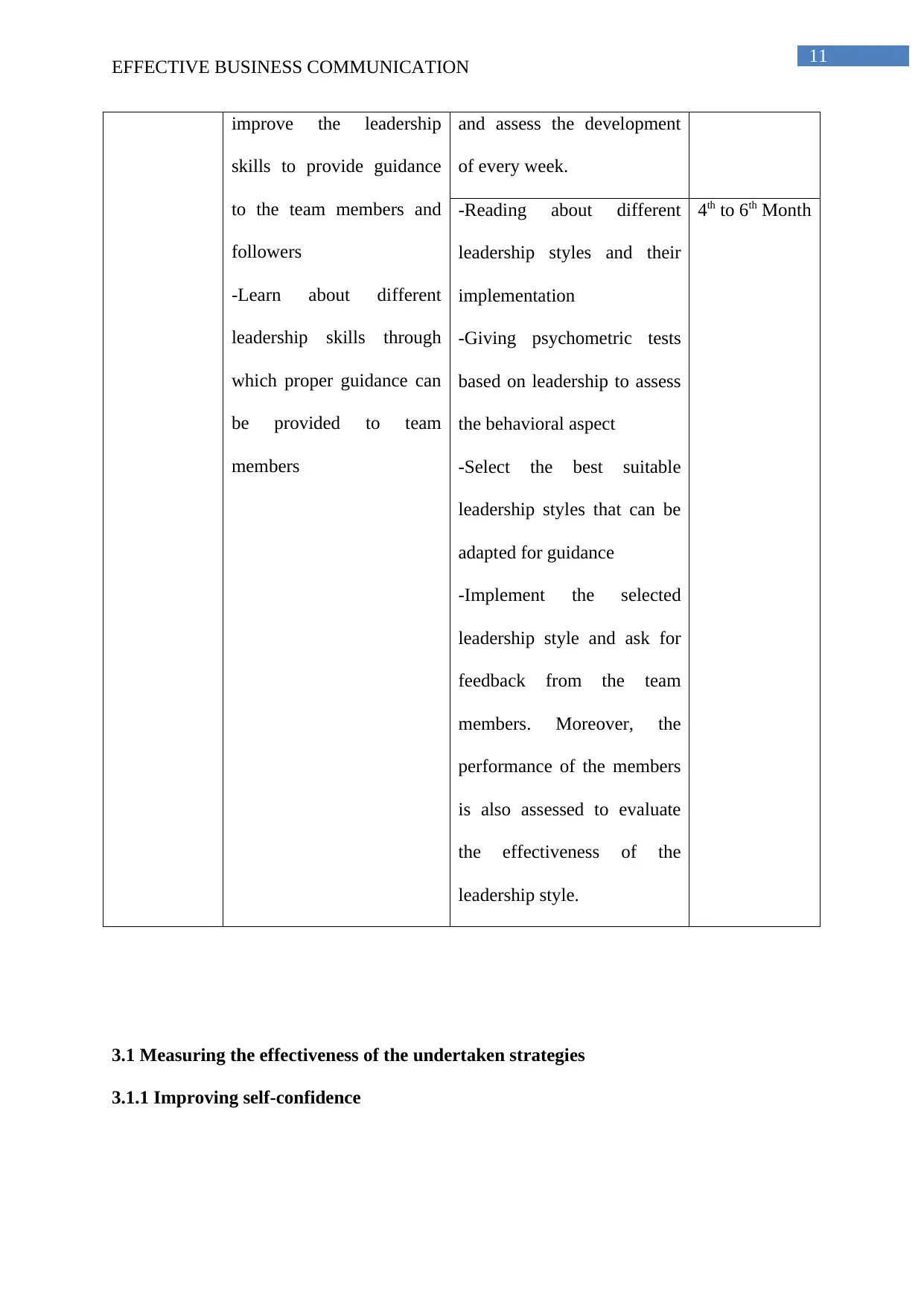
11
EFFECTIVE BUSINESS COMMUNICATION
improve the leadership
skills to provide guidance
to the team members and
followers
-Learn about different
leadership skills through
which proper guidance can
be provided to team
members
and assess the development
of every week.
-Reading about different
leadership styles and their
implementation
-Giving psychometric tests
based on leadership to assess
the behavioral aspect
-Select the best suitable
leadership styles that can be
adapted for guidance
-Implement the selected
leadership style and ask for
feedback from the team
members. Moreover, the
performance of the members
is also assessed to evaluate
the effectiveness of the
leadership style.
4th to 6th Month
3.1 Measuring the effectiveness of the undertaken strategies
3.1.1 Improving self-confidence
EFFECTIVE BUSINESS COMMUNICATION
improve the leadership
skills to provide guidance
to the team members and
followers
-Learn about different
leadership skills through
which proper guidance can
be provided to team
members
and assess the development
of every week.
-Reading about different
leadership styles and their
implementation
-Giving psychometric tests
based on leadership to assess
the behavioral aspect
-Select the best suitable
leadership styles that can be
adapted for guidance
-Implement the selected
leadership style and ask for
feedback from the team
members. Moreover, the
performance of the members
is also assessed to evaluate
the effectiveness of the
leadership style.
4th to 6th Month
3.1 Measuring the effectiveness of the undertaken strategies
3.1.1 Improving self-confidence
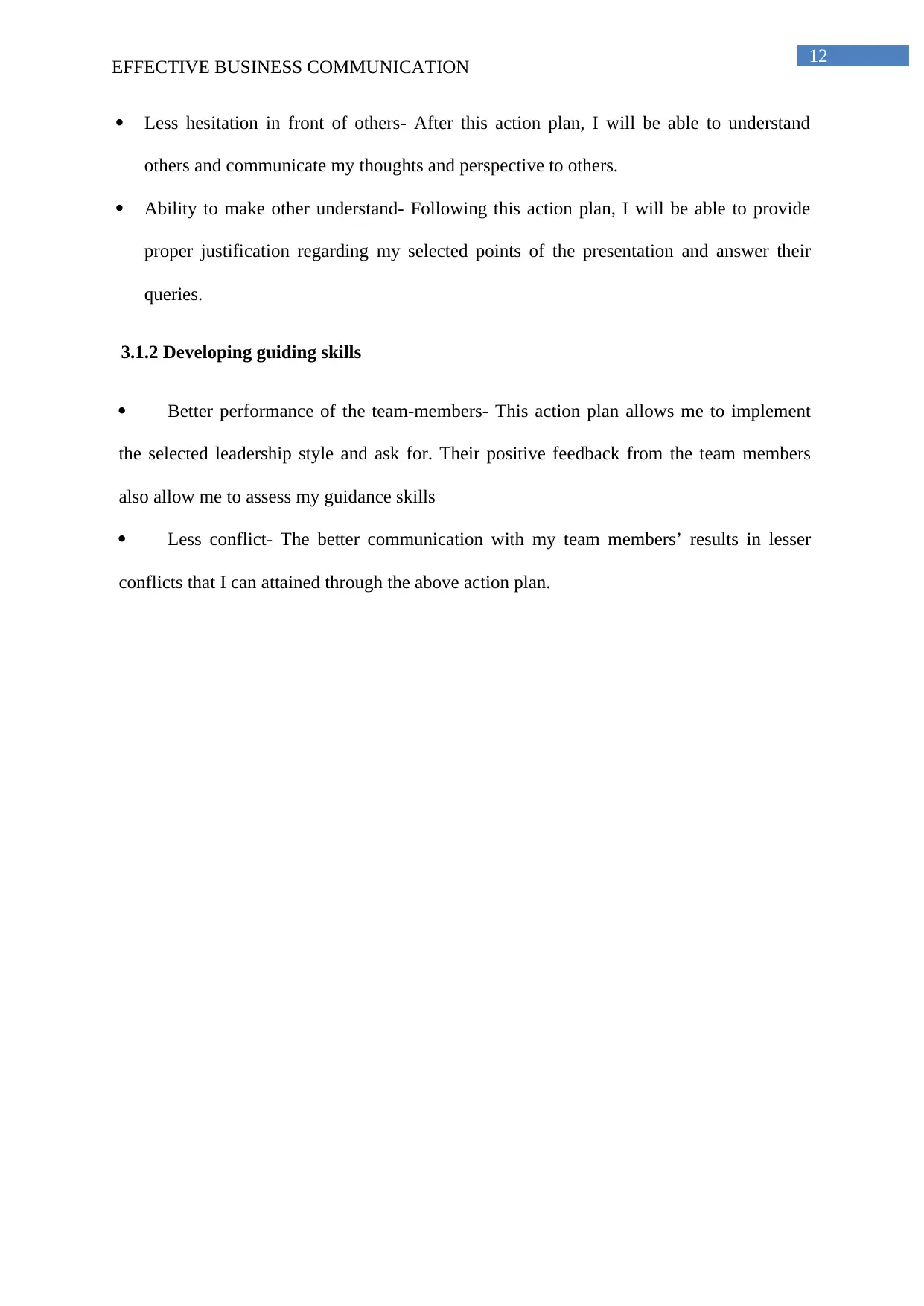
12
EFFECTIVE BUSINESS COMMUNICATION
Less hesitation in front of others- After this action plan, I will be able to understand
others and communicate my thoughts and perspective to others.
Ability to make other understand- Following this action plan, I will be able to provide
proper justification regarding my selected points of the presentation and answer their
queries.
3.1.2 Developing guiding skills
Better performance of the team-members- This action plan allows me to implement
the selected leadership style and ask for. Their positive feedback from the team members
also allow me to assess my guidance skills
Less conflict- The better communication with my team members’ results in lesser
conflicts that I can attained through the above action plan.
EFFECTIVE BUSINESS COMMUNICATION
Less hesitation in front of others- After this action plan, I will be able to understand
others and communicate my thoughts and perspective to others.
Ability to make other understand- Following this action plan, I will be able to provide
proper justification regarding my selected points of the presentation and answer their
queries.
3.1.2 Developing guiding skills
Better performance of the team-members- This action plan allows me to implement
the selected leadership style and ask for. Their positive feedback from the team members
also allow me to assess my guidance skills
Less conflict- The better communication with my team members’ results in lesser
conflicts that I can attained through the above action plan.
Paraphrase This Document
Need a fresh take? Get an instant paraphrase of this document with our AI Paraphraser
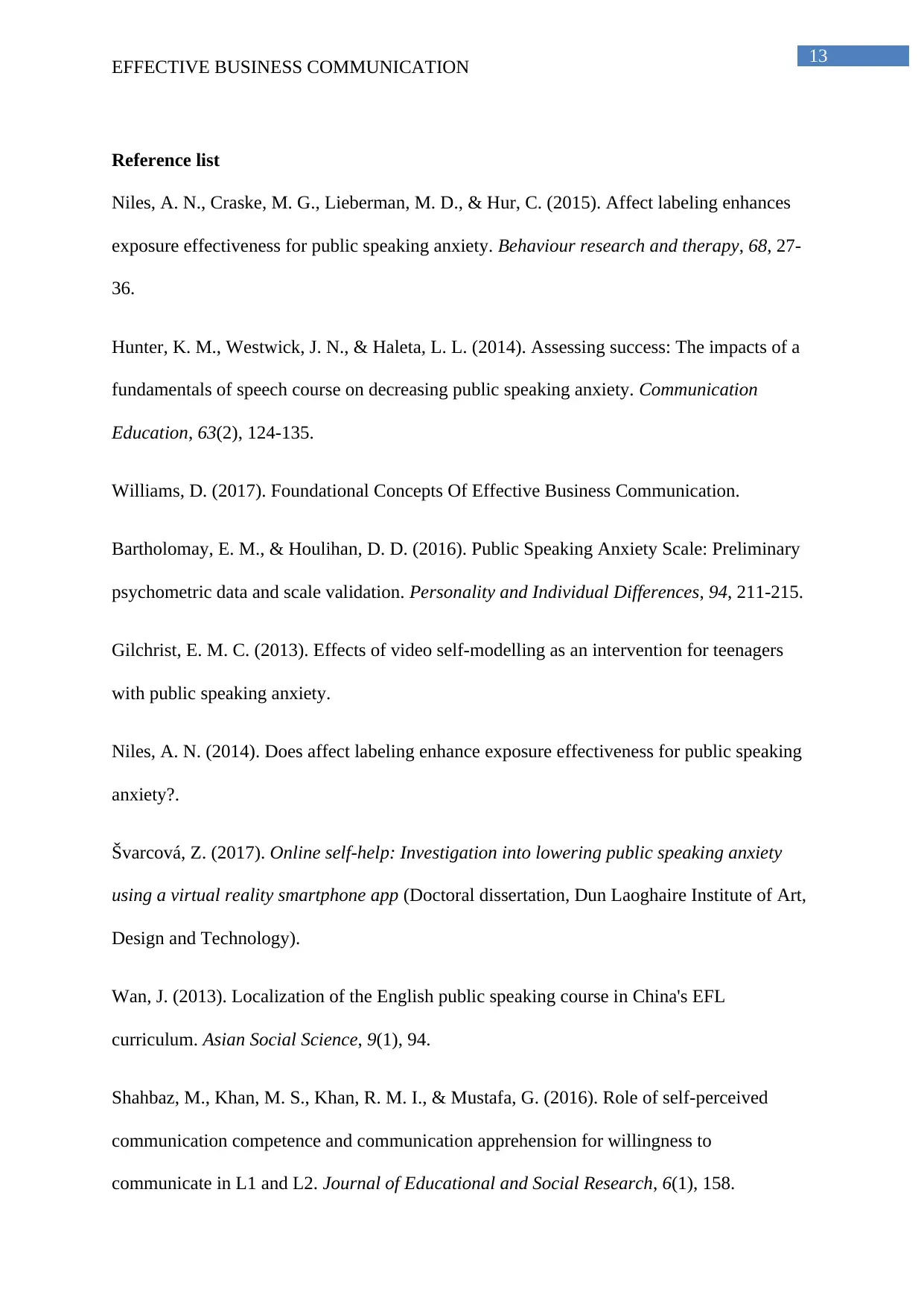
13
EFFECTIVE BUSINESS COMMUNICATION
Reference list
Niles, A. N., Craske, M. G., Lieberman, M. D., & Hur, C. (2015). Affect labeling enhances
exposure effectiveness for public speaking anxiety. Behaviour research and therapy, 68, 27-
36.
Hunter, K. M., Westwick, J. N., & Haleta, L. L. (2014). Assessing success: The impacts of a
fundamentals of speech course on decreasing public speaking anxiety. Communication
Education, 63(2), 124-135.
Williams, D. (2017). Foundational Concepts Of Effective Business Communication.
Bartholomay, E. M., & Houlihan, D. D. (2016). Public Speaking Anxiety Scale: Preliminary
psychometric data and scale validation. Personality and Individual Differences, 94, 211-215.
Gilchrist, E. M. C. (2013). Effects of video self-modelling as an intervention for teenagers
with public speaking anxiety.
Niles, A. N. (2014). Does affect labeling enhance exposure effectiveness for public speaking
anxiety?.
Švarcová, Z. (2017). Online self-help: Investigation into lowering public speaking anxiety
using a virtual reality smartphone app (Doctoral dissertation, Dun Laoghaire Institute of Art,
Design and Technology).
Wan, J. (2013). Localization of the English public speaking course in China's EFL
curriculum. Asian Social Science, 9(1), 94.
Shahbaz, M., Khan, M. S., Khan, R. M. I., & Mustafa, G. (2016). Role of self-perceived
communication competence and communication apprehension for willingness to
communicate in L1 and L2. Journal of Educational and Social Research, 6(1), 158.
EFFECTIVE BUSINESS COMMUNICATION
Reference list
Niles, A. N., Craske, M. G., Lieberman, M. D., & Hur, C. (2015). Affect labeling enhances
exposure effectiveness for public speaking anxiety. Behaviour research and therapy, 68, 27-
36.
Hunter, K. M., Westwick, J. N., & Haleta, L. L. (2014). Assessing success: The impacts of a
fundamentals of speech course on decreasing public speaking anxiety. Communication
Education, 63(2), 124-135.
Williams, D. (2017). Foundational Concepts Of Effective Business Communication.
Bartholomay, E. M., & Houlihan, D. D. (2016). Public Speaking Anxiety Scale: Preliminary
psychometric data and scale validation. Personality and Individual Differences, 94, 211-215.
Gilchrist, E. M. C. (2013). Effects of video self-modelling as an intervention for teenagers
with public speaking anxiety.
Niles, A. N. (2014). Does affect labeling enhance exposure effectiveness for public speaking
anxiety?.
Švarcová, Z. (2017). Online self-help: Investigation into lowering public speaking anxiety
using a virtual reality smartphone app (Doctoral dissertation, Dun Laoghaire Institute of Art,
Design and Technology).
Wan, J. (2013). Localization of the English public speaking course in China's EFL
curriculum. Asian Social Science, 9(1), 94.
Shahbaz, M., Khan, M. S., Khan, R. M. I., & Mustafa, G. (2016). Role of self-perceived
communication competence and communication apprehension for willingness to
communicate in L1 and L2. Journal of Educational and Social Research, 6(1), 158.
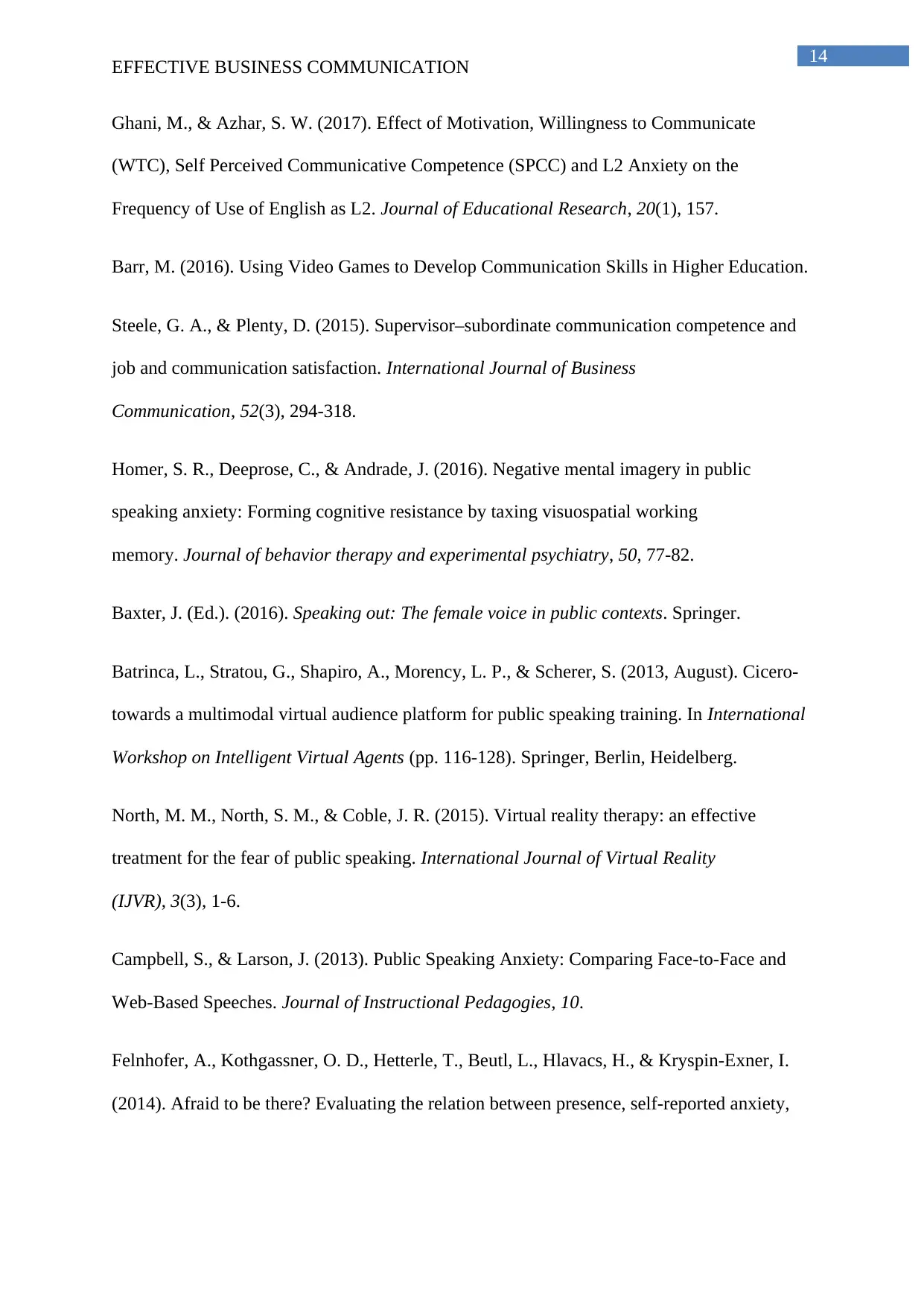
14
EFFECTIVE BUSINESS COMMUNICATION
Ghani, M., & Azhar, S. W. (2017). Effect of Motivation, Willingness to Communicate
(WTC), Self Perceived Communicative Competence (SPCC) and L2 Anxiety on the
Frequency of Use of English as L2. Journal of Educational Research, 20(1), 157.
Barr, M. (2016). Using Video Games to Develop Communication Skills in Higher Education.
Steele, G. A., & Plenty, D. (2015). Supervisor–subordinate communication competence and
job and communication satisfaction. International Journal of Business
Communication, 52(3), 294-318.
Homer, S. R., Deeprose, C., & Andrade, J. (2016). Negative mental imagery in public
speaking anxiety: Forming cognitive resistance by taxing visuospatial working
memory. Journal of behavior therapy and experimental psychiatry, 50, 77-82.
Baxter, J. (Ed.). (2016). Speaking out: The female voice in public contexts. Springer.
Batrinca, L., Stratou, G., Shapiro, A., Morency, L. P., & Scherer, S. (2013, August). Cicero-
towards a multimodal virtual audience platform for public speaking training. In International
Workshop on Intelligent Virtual Agents (pp. 116-128). Springer, Berlin, Heidelberg.
North, M. M., North, S. M., & Coble, J. R. (2015). Virtual reality therapy: an effective
treatment for the fear of public speaking. International Journal of Virtual Reality
(IJVR), 3(3), 1-6.
Campbell, S., & Larson, J. (2013). Public Speaking Anxiety: Comparing Face-to-Face and
Web-Based Speeches. Journal of Instructional Pedagogies, 10.
Felnhofer, A., Kothgassner, O. D., Hetterle, T., Beutl, L., Hlavacs, H., & Kryspin-Exner, I.
(2014). Afraid to be there? Evaluating the relation between presence, self-reported anxiety,
EFFECTIVE BUSINESS COMMUNICATION
Ghani, M., & Azhar, S. W. (2017). Effect of Motivation, Willingness to Communicate
(WTC), Self Perceived Communicative Competence (SPCC) and L2 Anxiety on the
Frequency of Use of English as L2. Journal of Educational Research, 20(1), 157.
Barr, M. (2016). Using Video Games to Develop Communication Skills in Higher Education.
Steele, G. A., & Plenty, D. (2015). Supervisor–subordinate communication competence and
job and communication satisfaction. International Journal of Business
Communication, 52(3), 294-318.
Homer, S. R., Deeprose, C., & Andrade, J. (2016). Negative mental imagery in public
speaking anxiety: Forming cognitive resistance by taxing visuospatial working
memory. Journal of behavior therapy and experimental psychiatry, 50, 77-82.
Baxter, J. (Ed.). (2016). Speaking out: The female voice in public contexts. Springer.
Batrinca, L., Stratou, G., Shapiro, A., Morency, L. P., & Scherer, S. (2013, August). Cicero-
towards a multimodal virtual audience platform for public speaking training. In International
Workshop on Intelligent Virtual Agents (pp. 116-128). Springer, Berlin, Heidelberg.
North, M. M., North, S. M., & Coble, J. R. (2015). Virtual reality therapy: an effective
treatment for the fear of public speaking. International Journal of Virtual Reality
(IJVR), 3(3), 1-6.
Campbell, S., & Larson, J. (2013). Public Speaking Anxiety: Comparing Face-to-Face and
Web-Based Speeches. Journal of Instructional Pedagogies, 10.
Felnhofer, A., Kothgassner, O. D., Hetterle, T., Beutl, L., Hlavacs, H., & Kryspin-Exner, I.
(2014). Afraid to be there? Evaluating the relation between presence, self-reported anxiety,

15
EFFECTIVE BUSINESS COMMUNICATION
and heart rate in a virtual public speaking task. Cyberpsychology, Behavior, and Social
Networking, 17(5), 310-316.
EFFECTIVE BUSINESS COMMUNICATION
and heart rate in a virtual public speaking task. Cyberpsychology, Behavior, and Social
Networking, 17(5), 310-316.
Secure Best Marks with AI Grader
Need help grading? Try our AI Grader for instant feedback on your assignments.
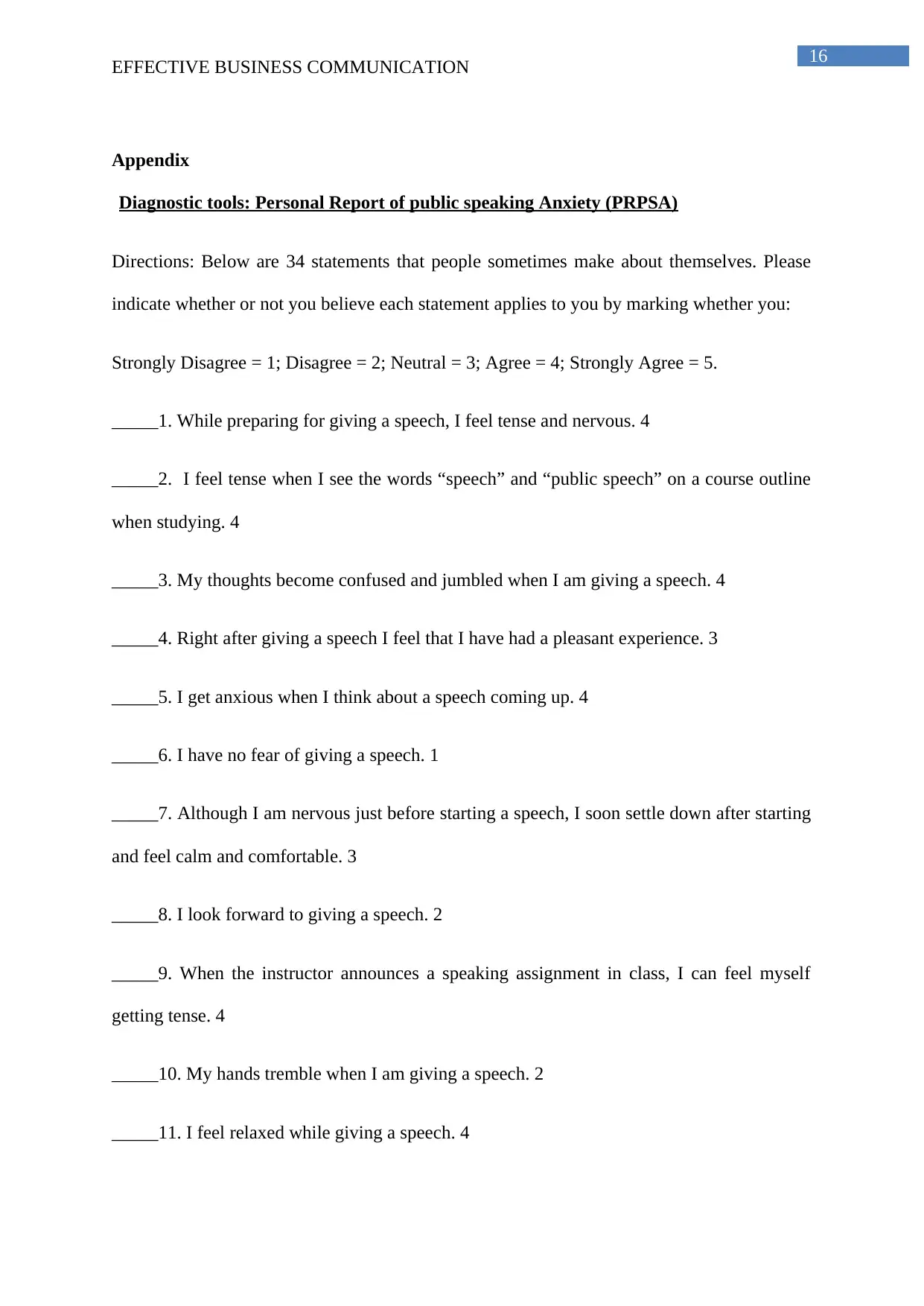
16
EFFECTIVE BUSINESS COMMUNICATION
Appendix
Diagnostic tools: Personal Report of public speaking Anxiety (PRPSA)
Directions: Below are 34 statements that people sometimes make about themselves. Please
indicate whether or not you believe each statement applies to you by marking whether you:
Strongly Disagree = 1; Disagree = 2; Neutral = 3; Agree = 4; Strongly Agree = 5.
_____1. While preparing for giving a speech, I feel tense and nervous. 4
_____2. I feel tense when I see the words “speech” and “public speech” on a course outline
when studying. 4
_____3. My thoughts become confused and jumbled when I am giving a speech. 4
_____4. Right after giving a speech I feel that I have had a pleasant experience. 3
_____5. I get anxious when I think about a speech coming up. 4
_____6. I have no fear of giving a speech. 1
_____7. Although I am nervous just before starting a speech, I soon settle down after starting
and feel calm and comfortable. 3
_____8. I look forward to giving a speech. 2
_____9. When the instructor announces a speaking assignment in class, I can feel myself
getting tense. 4
_____10. My hands tremble when I am giving a speech. 2
_____11. I feel relaxed while giving a speech. 4
EFFECTIVE BUSINESS COMMUNICATION
Appendix
Diagnostic tools: Personal Report of public speaking Anxiety (PRPSA)
Directions: Below are 34 statements that people sometimes make about themselves. Please
indicate whether or not you believe each statement applies to you by marking whether you:
Strongly Disagree = 1; Disagree = 2; Neutral = 3; Agree = 4; Strongly Agree = 5.
_____1. While preparing for giving a speech, I feel tense and nervous. 4
_____2. I feel tense when I see the words “speech” and “public speech” on a course outline
when studying. 4
_____3. My thoughts become confused and jumbled when I am giving a speech. 4
_____4. Right after giving a speech I feel that I have had a pleasant experience. 3
_____5. I get anxious when I think about a speech coming up. 4
_____6. I have no fear of giving a speech. 1
_____7. Although I am nervous just before starting a speech, I soon settle down after starting
and feel calm and comfortable. 3
_____8. I look forward to giving a speech. 2
_____9. When the instructor announces a speaking assignment in class, I can feel myself
getting tense. 4
_____10. My hands tremble when I am giving a speech. 2
_____11. I feel relaxed while giving a speech. 4

17
EFFECTIVE BUSINESS COMMUNICATION
_____12. I enjoy preparing for a speech. 4
_____13. I am in constant fear of forgetting what I prepared to say. 5
_____14. I get anxious if someone asks me something about my topic that I don’t know. 2
_____15. I face the prospect of giving a speech with confidence. 4
_____16. I feel that I am in complete possession of myself while giving a speech. 2
_____17. My mind is clear when giving a speech. 4
_____18. I do not dread giving a speech. 1
_____19. I perspire just before starting a speech. 4
_____20. My heart beats very fast just as I start a speech. 4
_____21. I experience considerable anxiety while sitting in the room just before my speech
starts. 3
_____22. Certain parts of my body feel very tense and rigid while giving a speech. 4
_____23. Realizing that only a little time remains in a speech makes me very tense and
anxious. 4
_____24. While giving a speech, I know I can control my feelings of tension and stress. 2
_____25. I breathe faster just before starting a speech. 2
_____26. I feel comfortable and relaxed in the hour or so just before giving a speech. 2
_____27. I do poorer on speeches because I am anxious. 5
_____28. I feel anxious when the teacher announces the date of a speaking assignment. 4
EFFECTIVE BUSINESS COMMUNICATION
_____12. I enjoy preparing for a speech. 4
_____13. I am in constant fear of forgetting what I prepared to say. 5
_____14. I get anxious if someone asks me something about my topic that I don’t know. 2
_____15. I face the prospect of giving a speech with confidence. 4
_____16. I feel that I am in complete possession of myself while giving a speech. 2
_____17. My mind is clear when giving a speech. 4
_____18. I do not dread giving a speech. 1
_____19. I perspire just before starting a speech. 4
_____20. My heart beats very fast just as I start a speech. 4
_____21. I experience considerable anxiety while sitting in the room just before my speech
starts. 3
_____22. Certain parts of my body feel very tense and rigid while giving a speech. 4
_____23. Realizing that only a little time remains in a speech makes me very tense and
anxious. 4
_____24. While giving a speech, I know I can control my feelings of tension and stress. 2
_____25. I breathe faster just before starting a speech. 2
_____26. I feel comfortable and relaxed in the hour or so just before giving a speech. 2
_____27. I do poorer on speeches because I am anxious. 5
_____28. I feel anxious when the teacher announces the date of a speaking assignment. 4

18
EFFECTIVE BUSINESS COMMUNICATION
_____29. When I make a mistake while giving a speech, I find it hard to concentrate on the
parts that follow. 5
_____30. During an important speech I experience a feeling of helplessness building up
inside me. 5
_____31. I have trouble falling asleep the night before a speech. 3
_____32.My heart beats very fast while I present a speech. 5
_____33. I feel anxious while waiting to give my speech. 5
_____34. While giving a speech, I get so nervous I forget facts I really know. 5
Score- 119
Self- Perceived Communication Competence Scale (SPCC)
Directions: Below are twelve situations in which you might need to communicate. People's
abilities to communicate effectively vary a lot, and sometimes the same person is more
competent to communicate in one situation than in another. Please indicate how competent
you believe you are to communicate in each of the situations described below. Indicate in the
space provided at the left of each item your estimate of your competence.
Presume 0 = completely incompetent and 100 = competent.
_____1. Present a talk to a group of strangers. 35
_____2. Talk with an acquaintance. 65
_____3. Talk in a large meeting of friends. 70
_____4. Talk in a small group of strangers. 30
EFFECTIVE BUSINESS COMMUNICATION
_____29. When I make a mistake while giving a speech, I find it hard to concentrate on the
parts that follow. 5
_____30. During an important speech I experience a feeling of helplessness building up
inside me. 5
_____31. I have trouble falling asleep the night before a speech. 3
_____32.My heart beats very fast while I present a speech. 5
_____33. I feel anxious while waiting to give my speech. 5
_____34. While giving a speech, I get so nervous I forget facts I really know. 5
Score- 119
Self- Perceived Communication Competence Scale (SPCC)
Directions: Below are twelve situations in which you might need to communicate. People's
abilities to communicate effectively vary a lot, and sometimes the same person is more
competent to communicate in one situation than in another. Please indicate how competent
you believe you are to communicate in each of the situations described below. Indicate in the
space provided at the left of each item your estimate of your competence.
Presume 0 = completely incompetent and 100 = competent.
_____1. Present a talk to a group of strangers. 35
_____2. Talk with an acquaintance. 65
_____3. Talk in a large meeting of friends. 70
_____4. Talk in a small group of strangers. 30
Paraphrase This Document
Need a fresh take? Get an instant paraphrase of this document with our AI Paraphraser
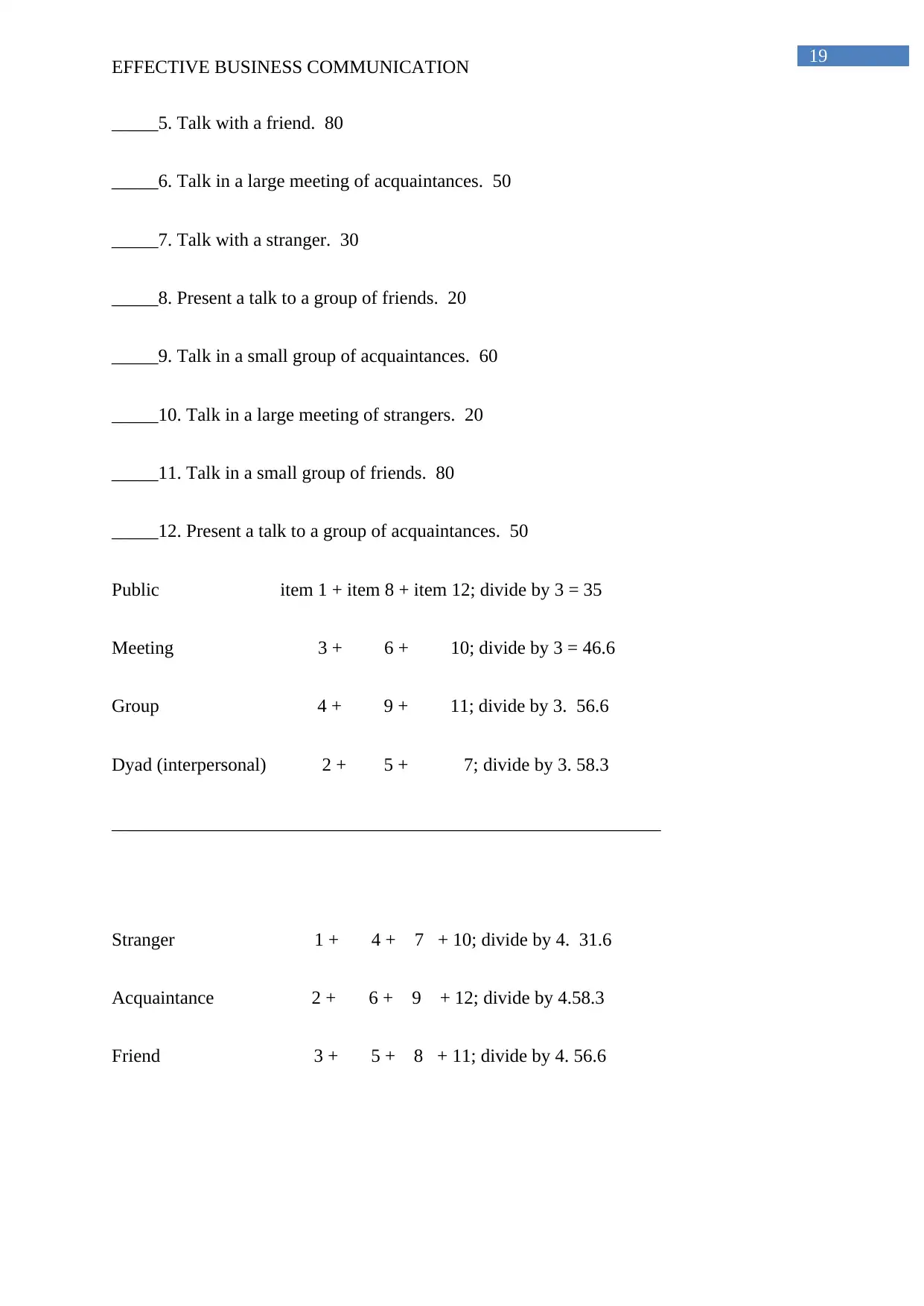
19
EFFECTIVE BUSINESS COMMUNICATION
_____5. Talk with a friend. 80
_____6. Talk in a large meeting of acquaintances. 50
_____7. Talk with a stranger. 30
_____8. Present a talk to a group of friends. 20
_____9. Talk in a small group of acquaintances. 60
_____10. Talk in a large meeting of strangers. 20
_____11. Talk in a small group of friends. 80
_____12. Present a talk to a group of acquaintances. 50
Public item 1 + item 8 + item 12; divide by 3 = 35
Meeting 3 + 6 + 10; divide by 3 = 46.6
Group 4 + 9 + 11; divide by 3. 56.6
Dyad (interpersonal) 2 + 5 + 7; divide by 3. 58.3
___________________________________________________________
Stranger 1 + 4 + 7 + 10; divide by 4. 31.6
Acquaintance 2 + 6 + 9 + 12; divide by 4.58.3
Friend 3 + 5 + 8 + 11; divide by 4. 56.6
EFFECTIVE BUSINESS COMMUNICATION
_____5. Talk with a friend. 80
_____6. Talk in a large meeting of acquaintances. 50
_____7. Talk with a stranger. 30
_____8. Present a talk to a group of friends. 20
_____9. Talk in a small group of acquaintances. 60
_____10. Talk in a large meeting of strangers. 20
_____11. Talk in a small group of friends. 80
_____12. Present a talk to a group of acquaintances. 50
Public item 1 + item 8 + item 12; divide by 3 = 35
Meeting 3 + 6 + 10; divide by 3 = 46.6
Group 4 + 9 + 11; divide by 3. 56.6
Dyad (interpersonal) 2 + 5 + 7; divide by 3. 58.3
___________________________________________________________
Stranger 1 + 4 + 7 + 10; divide by 4. 31.6
Acquaintance 2 + 6 + 9 + 12; divide by 4.58.3
Friend 3 + 5 + 8 + 11; divide by 4. 56.6
1 out of 20
Related Documents
Your All-in-One AI-Powered Toolkit for Academic Success.
+13062052269
info@desklib.com
Available 24*7 on WhatsApp / Email
![[object Object]](/_next/static/media/star-bottom.7253800d.svg)
Unlock your academic potential
© 2024 | Zucol Services PVT LTD | All rights reserved.





